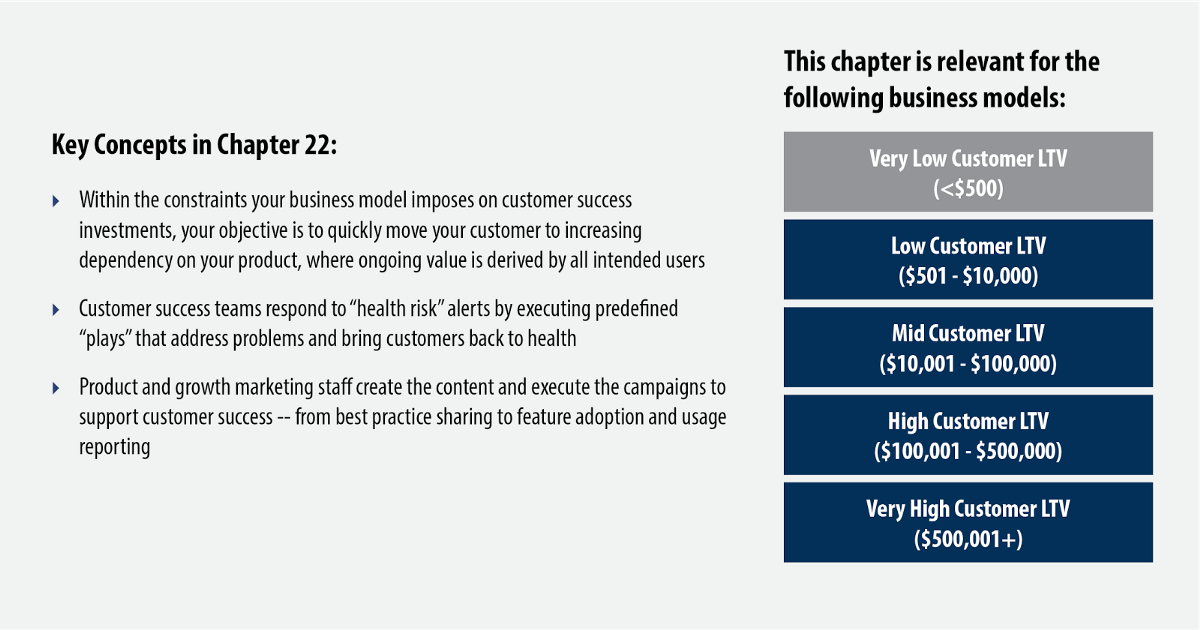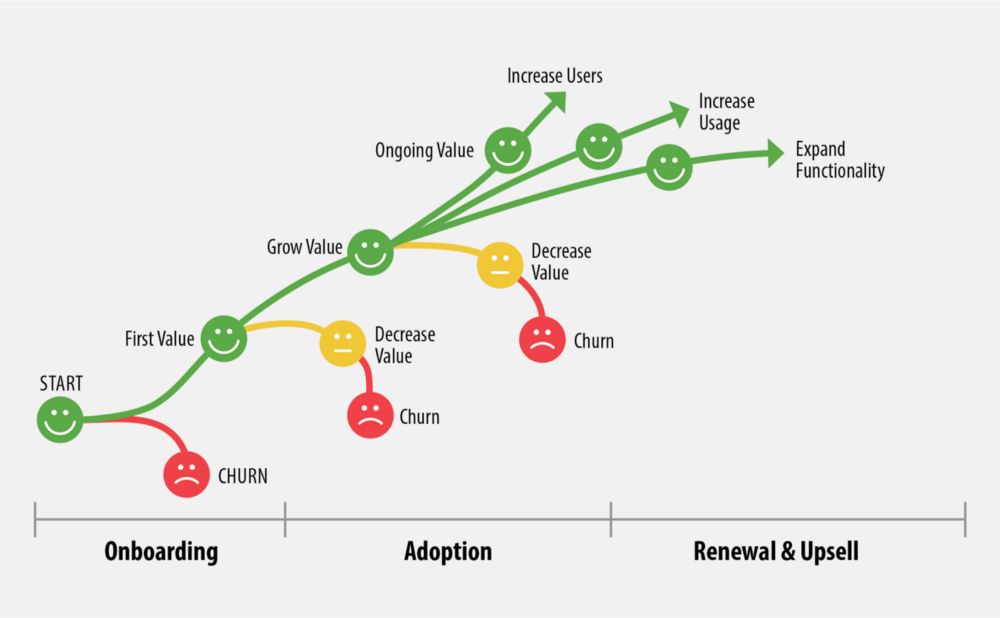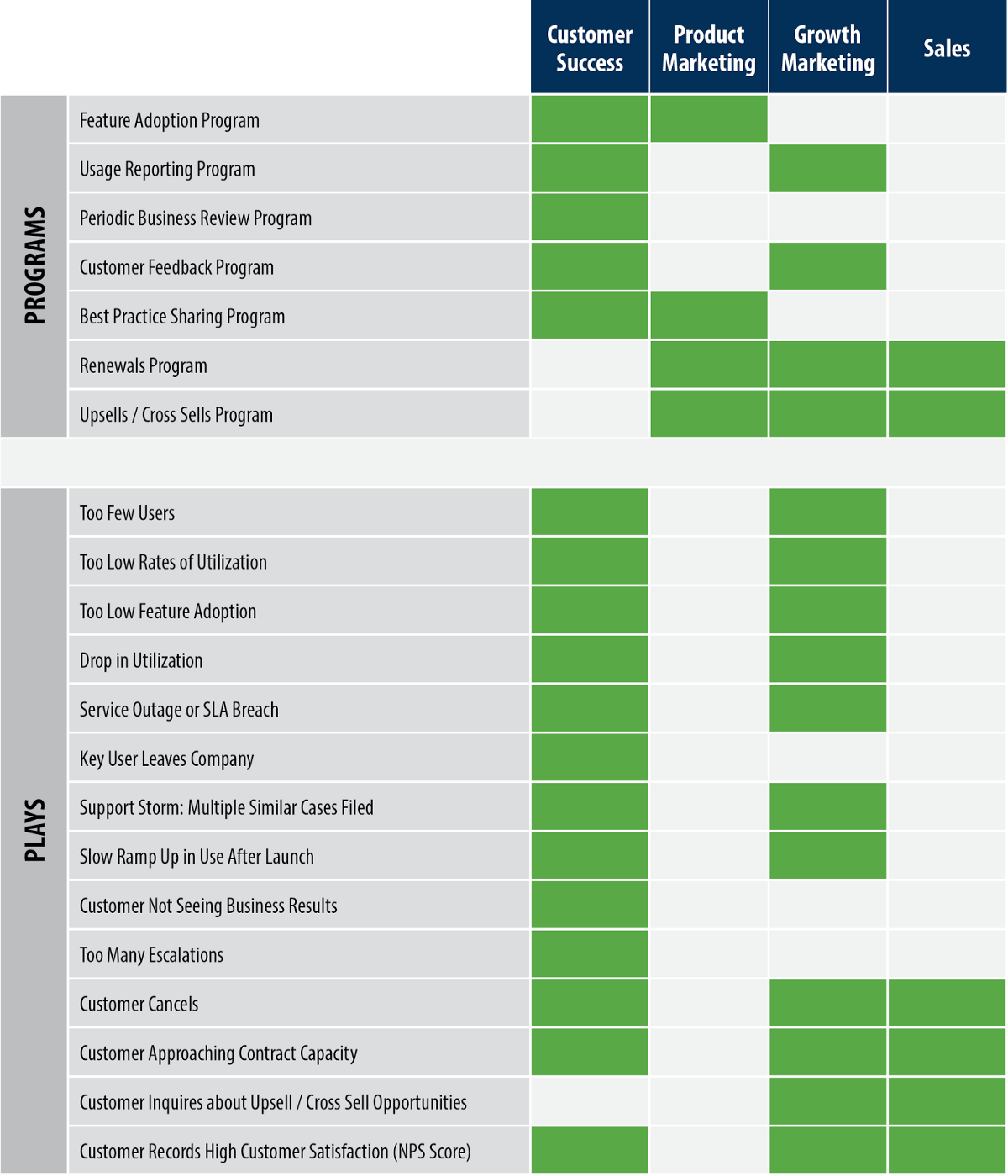“They set me up, settled me in, and showed me success,” said the satisfied customer.

This chapter concerns the Stabilize domain of the Bow Tie:

Let’s assume you have sold a B2B SaaS product to a customer. You’ve just completed the launch in which you successfully activated your product inside your customer’s technical environment. You trained the users (executive, administrative, and functional), and confirmed that they are regularly using the product in a way that at least meets minimum thresholds.
Good job. You have passed your first test. Now you need to move your new customer deliberately from “fingers crossed” to advocacy lock (“I’m a raving fan”). You have just eight weeks or so to do it before your customer’s first impressions — good or bad — harden into cement.
These eight weeks comprise the Stabilize domain in the Bow Tie framework. Here, you rapidly grow your value to your customer, as manifested in rapid adoption of users, usage rate, and functionality. Guy Nirpaz, CEO of the customer success platform Totango, maps it like this:¹

The functions responsible for growing value are customer success, product marketing, and growth marketing. Once you prove success and create a happy customer, sales may be presented with up-selling and cross-selling opportunities. Your business model will gate the level of investment placed into these functions.
Driven by your business model, the stabilize strategy begins with some fundamental questions:
- Given LTV and the financial impact of reduced churn and increased up-sell and renewal revenue, what monthly investments in customer success are possible?
- Within these financial constraints, what high-level actions for nurturing, harvesting (renewal / up-sell / cross-sell), and saving activities deliver optimal customer success outcomes?
- How do these actions impact organization design, including customer-to-staff ratios?
The answers to these questions will help you determine the mix of customer success, product marketing, and growth marketing initiatives required to optimize customer satisfaction and the sales resources necessary to exploit expansion potential.
In the Stabilize domain of the Bow Tie, the playbooks for customer success, product marketing, and growth marketing include the following programs and plays:

Customer Success
The old model for customer care was the “account manager” model. The idea was to maintain a consistent human connection with the customer via scheduled monthly calls. These calls were part “check-in,” part “on-the-spot training,” part “up-sell opportunity detection” — sort of like an annual doctor checkup. To staff adequately for the regular calls to all customers, ratios above 60 customers per account manager were not possible.
The problems with this model are that it’s rigid, inefficient, and poorly timed. Not all customers are alike. Some are already happy, productive users and don’t need to waste time talking with you. On the other hand, for the customer who has fallen into a low-use pattern, quick intervention is critical: you can’t wait until the next monthly call pops up.
The new customer success model is proactive and data-driven.
It requires that you can report, by customer, the percentage of intended users that are using the system at all, utilization rate by user and overall, feature adoption by user and overall, and, if possible, measured business outcomes resulting from your product’s use.
At the department level, the metrics dashboard tracks both activity and outcome metrics.
Activity metrics:
- Utilization (# / % customers at 25% / 50% / 75% of purchased seats used)
- Frequency of use (daily or monthly average use: # of customers at 0 / 1 / 5 / 10 uses per day)
- The percent of features used (# / % of customers with 25% / 50% / 75% of features used)
- Types of features used
- Escalations (by revenue / by % of base / by first-time escalation vs. multiple escalations / by length of open escalation)
- Launch took too long (over 30 days / over 60 days)
Outcome metrics:
- Customer satisfaction data such as Net Promoter Score(NPS) (right after launch, at three months and ten months)
- Customer business outcome metrics (proof of value)
- Retention rate
- Up-sell / cross-sell rate
- Churn rate
- Revenue
Turn these metrics into your customer success dashboard and manage the business accordingly. Continuous improvement should show up in the metrics (higher rates of utilization, use, and adoption; higher customer satisfaction, retention, expansion, and LTV scores).
The activity data enables you to act. If your business model supports it, you can send customer success managers (CSMs) alerts when a threshold is crossed. The CSM can then reach out to the customer right away, with a precise understanding of the problem. The fix happens quickly. It is confirmed by data. And it’s super efficient.
With High and Very High LTV business models, even though the planned meetings may be less frequent than under the old account manager model, CSMs still do hold them. In these meetings, you can execute the following programs:
- Feature adoption program (to review customer data on feature use, discuss value of underutilized features and, if necessary, train)
- Usage reporting program (to communicate value provided during a period of time)
- Periodic business review program (to discuss / review business outcomes)
- Customer feedback program (to discuss customer feedback / NPS score results)
- Best practice sharing program (to discuss best practices, especially in areas of underutilization)
It is also possible to send “health risk” alerts to CSMs. Here it’s important to execute the right play. Document and train CSMs on your success plays for:
- Too few users
- Too low rates of utilization
- Too low feature adoption
- Account suffers from drop in utilization
- Users affected by service outage or SLA breach
- A key user leaves the company
- A support storm — multiple similar cases from multiple customers
- Slow ramp up in use after launch
- Customer not seeing business results
- Too many escalations
- Customer cancels
- Customer approaching utilization capacity
- Customer inquires about up-sell / cross-sell opportunities
- Customer records very high customer satisfaction (NPS) score
Product and Growth Marketing
Product marketing generates the content, and growth marketing executes the distribution for a series of programs and plays.
Programs
- Usage reporting program (send usage reports to customer)
- Feature adoption program (nurture email campaign)
- Best practice sharing program (nurture email campaign)
- Customer feedback program (send surveys to customer)
- Renewals program (nurture campaign underscoring customer value, timed ahead of renewal date)
- Up-sells / cross-sells program (nurture campaign to communicate value of up-sells / cross-sells)
Plays
- Too few users
- Too low rates of utilization
- Too low feature adoption
- Drop in utilization
- Slow ramp up in use after launch
- Customer cancels
- Customer approaching contract capacity
- Customer inquiries about up-sell / cross-sell opportunities
- Customer records high customer satisfaction
The growth marketing team will also be enlisted to support communications to customers regarding unexpected events:
- Service outage or SLA breach
- Support storm: multiple similar cases filed
Summary
At the end of the day, the mission of the Stabilize domain is to create customer success, through smart, customer-centric programs and plays, informed by data.
If you can reach the “third month live” with a happy, highly product-engaged customer, you’ve conquered the toughest, most critical leg of the journey.
From then on it’s about staying ahead of the customer — continuously adding incremental value until the opportunity arises to expand use.
If you can execute this mission day in day out, with every customer, you open the door to a rapidly scaling growth path.
Scale on!
. . .
If you would like more CEO insights into scaling your revenue engine and building a high-growth tech company, please visit us at CEOQuest.com, and follow us on LinkedIn, Twitter, Facebook, and YouTube.
. . .
Notes:
1. Guy Nirpaz and Fernando Pizzaro. Farm, Don’t Hunt: The Definitive Guide to Customer Success. Self-published, 2016.
. . .
If you would like more CEO insights into scaling your revenue engine and building a high-growth tech company, please visit us at CEOQuest.com, and follow us on LinkedIn, Twitter, Facebook, and YouTube.

